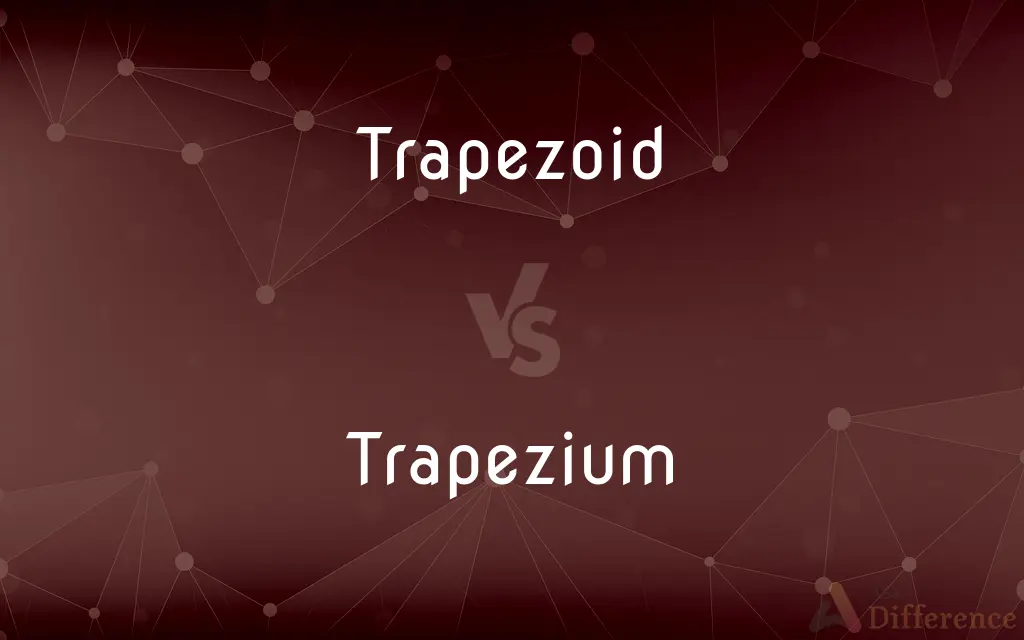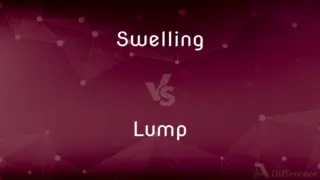Trapezoid vs. Trapezium — What's the Difference?
By Tayyaba Rehman — Updated on November 2, 2023
In American English, a trapezoid has at least one pair of parallel sides; in British English, a trapezium has no parallel sides.

Difference Between Trapezoid and Trapezium
Table of Contents
ADVERTISEMENT
Key Differences
In the United States, a trapezoid is defined as a four-sided figure with at least one pair of parallel sides. The term "trapezoid" is consistently used in American English to describe such a shape, which is a common figure in geometry. In contrast, British English uses the term "trapezium" to refer to a shape with no parallel sides, different from the American definition.
The word "trapezium" in British English defines a quadrilateral with no sides parallel. This is in direct contrast to the American "trapezoid," which requires the presence of parallel sides. The British "trapezium" aligns with what Americans would call an irregular quadrilateral, showcasing a clear difference in terminology between the two versions of English.
Conversely, in British English, a "trapezoid" actually refers to what Americans would call a "trapezium": a four-sided figure with at least one pair of parallel sides. This switch in terminology can cause confusion when discussing geometric figures across different English-speaking regions. It's important to clarify the context when using these terms in an international setting.
Despite the difference in terminology, both the American "trapezoid" and the British "trapezium" share the characteristic of being quadrilaterals. This means they both have four sides, but the comparison essentially stops there due to the differing requirements regarding parallel sides.
Educational standards in geometry reflect these terminological differences. In the U.S., students learn about trapezoids as part of the standard geometric curriculum, while in the U.K., students learn about trapeziums, although the figures they study are not the same due to the variation in definitions between the two cultures.
ADVERTISEMENT
Comparison Chart
Parallel Sides
At least one pair of parallel sides.
No parallel sides.
British Equivalent
The British equivalent is "trapezium".
The British equivalent is "trapezoid".
American Equivalent
—
The American equivalent is an irregular quadrilateral.
Shape Type
A type of quadrilateral.
A type of quadrilateral.
Educational Focus
Taught in American schools as "trapezoid".
Taught in British schools as "trapezium".
Compare with Definitions
Trapezoid
In architecture, a trapezoid can describe a skewed rectangular structure.
The window frames were designed with a trapezoid outline.
Trapezium
In British English, a quadrilateral with no parallel sides.
The geometric figure was clearly a trapezium because none of its sides were parallel.
Trapezoid
A quadrilateral with at least one pair of parallel sides.
The plot of land was shaped like a trapezoid.
Trapezium
In the U.K., a trapezium may refer to an irregular polygon without parallel sides.
He argued that a parallelogram could not be a trapezium.
Trapezoid
In U.S. geometry, a trapezoid is a specific type of polygon.
We calculated the area of a trapezoid in math class today.
Trapezium
A trapezium can also refer to a bone in the wrist.
The X-ray showed that she had fractured her trapezium.
Trapezoid
A flat shape with four straight sides where usually two sides are parallel.
The artist drew a trapezoid to demonstrate perspective.
Trapezium
A trapezium is sometimes used in artistic designs for its irregular shape.
The garden was laid out in the shape of a trapezium.
Trapezoid
In Euclidean geometry, a convex quadrilateral with at least one pair of parallel sides is referred to as a trapezium () in English outside North America, but as a trapezoid () in American and Canadian English. The parallel sides are called the bases of the trapezoid and the other two sides are called the legs or the lateral sides (if they are not parallel; otherwise there are two pairs of bases).
Trapezium
A four-sided polygon with no parallel sides and no sides equal; a simple convex irregular quadrilateral.
Trapezoid
A quadrilateral having two parallel sides.
Trapezium
A quadrilateral with no parallel sides
Trapezoid
Chiefly British A trapezium.
Trapezium
A trapezium is a shape often studied in U.K. mathematics.
On the test, there was a question about finding the perimeter of a trapezium.
Trapezoid
(Anatomy) A small bone in the wrist, situated near the base of the index finger.
Trapezium
A quadrilateral having no parallel sides.
Trapezoid
(Sports) An area in the shape of a trapezoid marked behind the goal line and the goal in ice hockey, where the goalie is allowed to play the puck.
Trapezium
Chiefly British A trapezoid.
Trapezoid
A (convex) quadrilateral with two (non-adjacent) parallel sides.
Trapezium
(Anatomy)A bone in the wrist at the base of the thumb.
Trapezoid
A convex quadrilateral with no sides parallel.
Trapezium
A quadrilateral with two sides parallel.
Trapezoid
(anatomy) The trapezoid bone of the wrist.
Trapezium
(restrictively) A quadrilateral with two sides parallel and two sides non-parallel.
Trapezoid
A plane four-sided figure, having two sides parallel to each other.
Trapezium
(anatomy) The trapezium bone of the wrist.
Trapezoid
A bone of the carpus at the base of the second metacarpal, or index finger.
Trapezium
A region on the ventral side of the brain, either just back of the pons Varolii, or, as in man, covered by the posterior extension of its transverse fibers.
Trapezoid
Having the form of a trapezoid; trapezoidal; as, the trapezoid ligament which connects the coracoid process and the clavicle.
Trapezium
A plane figure bounded by four right lines, of which no two are parallel.
Trapezoid
Of or pertaining to the trapezoid ligament; as, the trapezoid line.
Trapezium
A bone of the carpus at the base of the first metacarpal, or thumb.
Trapezoid
A quadrilateral with two parallel sides
Trapezium
A multiple star in the constellation of Orion
Trapezoid
The wrist bone between the trapezium and the capitate bones
Trapezium
The wrist bone on the thumb side of the hand that articulates with the 1st and 2nd metacarpals
Trapezoid
A trapezoid is a four-sided figure with non-equal angles.
The tabletop's trapezoid shape gave it a modern look.
Common Curiosities
Are trapezoids and trapeziums the same shape in different countries?
No, they refer to different shapes depending on whether you're using U.S. or U.K. terminology.
Is a square a type of trapezoid in the U.S.?
By the broad definition, a square could be considered a type of trapezoid since it has two pairs of parallel sides.
Can a trapezoid have more than one pair of parallel sides?
If a quadrilateral has two pairs of parallel sides, it is typically called a parallelogram, not a trapezoid.
How does the U.K. define a trapezium?
In the U.K., a trapezium is a quadrilateral with no parallel sides.
Does a trapezium have right angles?
A trapezium can have right angles, but it's not a defining characteristic.
What defines a trapezoid in the U.S.?
In the U.S., a trapezoid is defined as a quadrilateral with at least one pair of parallel sides.
What’s another name for an American trapezoid in British English?
The British English equivalent for an American trapezoid is "trapezium."
What is the main difference in the definitions of trapezoid and trapezium?
The main difference lies in the presence or absence of parallel sides.
Are the terms trapezoid and trapezium interchangeable?
They are not interchangeable; their usage depends on the regional variation of English being used.
Can a trapezoid be symmetrical?
A trapezoid can be symmetrical if it has a line of symmetry through the midpoints of its non-parallel sides.
How do teachers explain the difference between trapezoid and trapezium to students?
Teachers often explain the difference by referencing the regional definitions and showing examples of each shape.
Share Your Discovery

Previous Comparison
Swelling vs. Lump
Next Comparison
Iridescent vs. OpalescentAuthor Spotlight
Written by
Tayyaba RehmanTayyaba Rehman is a distinguished writer, currently serving as a primary contributor to askdifference.com. As a researcher in semantics and etymology, Tayyaba's passion for the complexity of languages and their distinctions has found a perfect home on the platform. Tayyaba delves into the intricacies of language, distinguishing between commonly confused words and phrases, thereby providing clarity for readers worldwide.












































